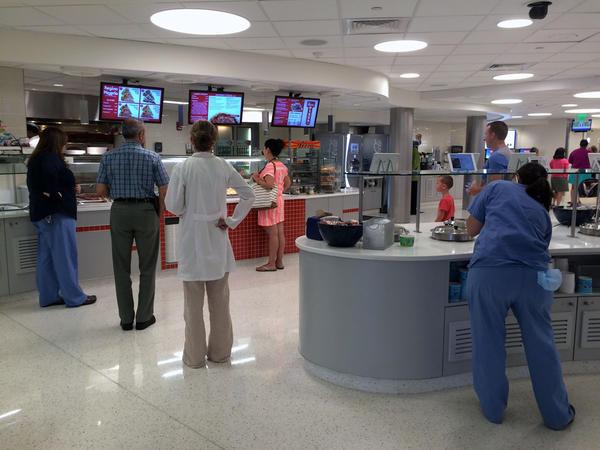Workers browse the cafeteria at Children's Hospital in Boston, Mass.
Boston Children's Hospital used to serve stereotypically bad hospital food — prepackaged stuff with plenty of preservatives.
But if a hospital wants to be on the cutting edge of healthcare, says hospital manager Paul O'Connor, it also has to focus on the most nutritious food possible — local food.
"If you’re going to be called No. 1 in the world from a pediatric perspective, you better be doing it from a food perspective too,” O’Connor says.
So five years ago, the hospital decided to go as local as possible. The problem, O’Connor says, was the hospital couldn’t just switch. Children’s gets its food from big distribution companies, which in turn rely on national contractors who can deliver a lot of food at once.
Now the hospital is, pardon the pun, turning the tables. Children’s is working with other hospitals to force food distributors to buy in new ways. For the last five years the hospitals have coordinated to demand more local food products. The change is good news for local farmers and fishermen who have been locked out the market for big local companies and institutions that buy vast amounts of food in bulk.
Stacia Clinton, New England regional director for the group Health Care Without Harm, who helps the hospitals collaborate, says half of all New England hospitals are participating in the effort.
“Hospitals are anchor institutions,” she says. “They own real estate, they provide jobs in the community, so they have a great impact in many different ways. And so by using their programs and purchasing and messaging, they have the ability to motivate change, not only inside their facility but beyond in the community and then more broadly in the marketplace and policy.”
In a clear sign that the local food movement is growing, some national food distributors are responding to demand by building local networks. One distributor, Sodexo, stopped relying so much on national contractors, and in fiscal 2014 bought $10 million in local produce, says Richard Garcia, a former Boston chef who directs buying for Sodexo.
"Prior to really going on this local kick, our vendors would be sourcing tomatoes from California, for example," he said. "We weren’t really paying attention to where it was coming from. There’s definitely a lot more work involved in going local."
Small farmers with guaranteed demand from hospitals can plan for steady growth and invest more in their businesses. That’s allowed local producers to break through barriers that have held them back — like Jared Auerbach of Red’s Best, a Boston fish distributor, who says he battles the perception that local seafood is high-end stuff, only suitable for top chefs or for shipping to far away restaurants. But fishermen pull plenty of nutritious fish out of the ocean that isn’t expensive.
“The reality of oceans is you never really know what’s going to come in,” Auerbach says. “The biggest challenge is really just getting consumers to be flexible in their demand.”
The hospitals are willing to be flexible, so Auerbach says big food distributors have tapped him — and now he buys from about a thousand local, independent fishermen to meet the demand.
“I give the big guys all the credit in the world,” he says. “But it all comes down to consumer demand. Businesses respond to their consumers' needs, and that’s what we’re seeing. This is because of the people asking for it that this is happening.”
Extremely Fresh
Having local food available gives hospitals more options, but they also have to be willing to do more work. This summer, children’s unveiled a sleek new food court billed as local and fresh. O’Connor pointed to a beet salad and said every single beet had to be cut up in the hospital's kitchens.
“Now that is extremely time consuming,” he says. “I go back there every day and just shake my head at the poor people back there who have to do it.”
That extra work can be a barrier to buying local for hospitals, Clinton says.
“Hospitals say, 'Great, I’ll purchase it,' and they bring in all this fresh produce, and then they find 'Oh my gosh, I don’t have the time, the labor or even sometimes the skills,’” she says.

The extra work does mean cooking local is more expensive. Children's has made up for that by making portion sizes smaller — or as they call it, "right-sizing." The hospital has also changed its pricing in an unexpected, yet common-sense way — its unhealthy food is more expensive, while the healthy stuff is cheaper.
"You’re not going to find the price is outrageously different,” O’Connor says. “[But] if there was an option of something that might be perceived as unhealthy than you might see the price a little higher there.”
In the fresh-food court, milk is free for kids and apples are free for everybody. But the healthier choices aren’t being forced upon patients and visitors. There is regularly-priced pizza one counter, and another dozen options a half-block away. But O’Connor says the hospital is committed to steadily converting more items in children’s food court to locally-sourced.
“We’ll never get to that point, 100 percent," he says. "Because unfortunately, the winter months that New England has, you’re not always going to get everything right from here. But we can certainly do everything we can to get to that point.”
O’Connor says healthcare and healthy food are linked — and that means if anyone should be encouraging people to eat more locally grown food, it’s hospitals like Children’s — especially since they have the buying power to do it.
A version of this story first appeared on WGBHNews.org. This story is part of a partnership between WGBH News and the American Academy of Arts and Sciences exploring the issues around our food. You can find the entire series here.
Our coverage reaches millions each week, but only a small fraction of listeners contribute to sustain our program. We still need 224 more people to donate $100 or $10/monthly to unlock our $67,000 match. Will you help us get there today?
